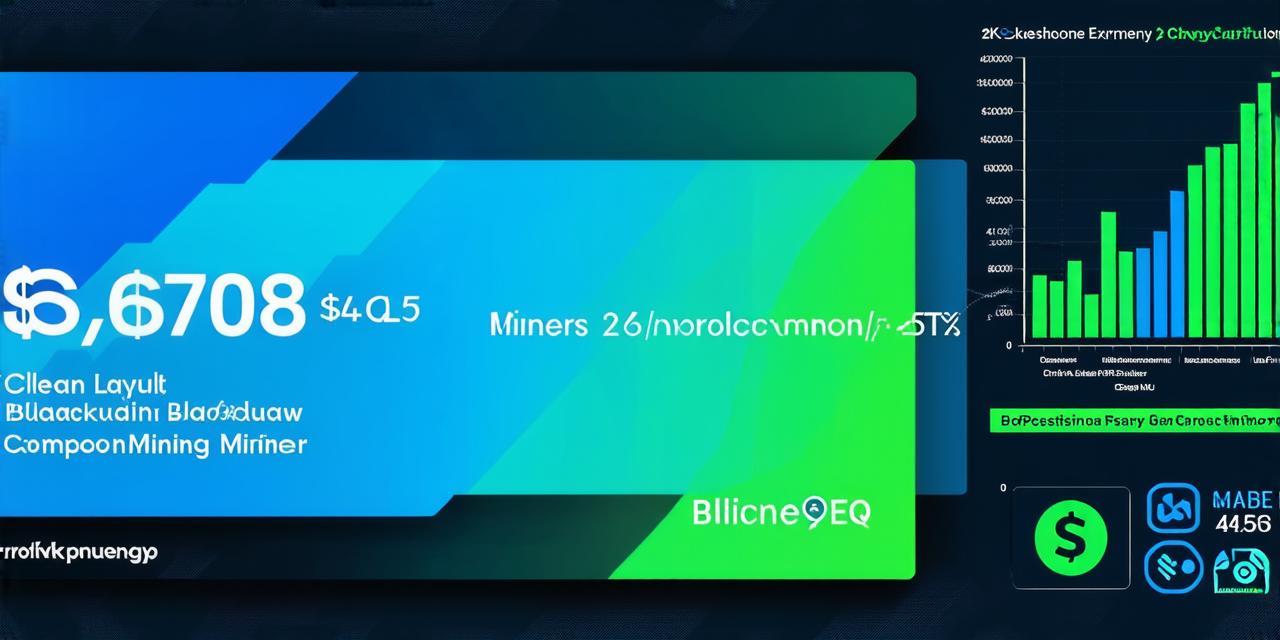What is Blockchain Mining?
Blockchain mining is the process of verifying transactions on a blockchain network. It involves running complex computations to validate transactions and add them to the blockchain. In return for their efforts, miners are rewarded with cryptocurrency, which they can then sell or hold as an investment.
Factors that Determine Miner’s Earning Potential
1. Type of Cryptocurrency Being Mined
The type of cryptocurrency being mined is one of the most important factors that determine a miner’s earnings potential. Some cryptocurrencies have a higher mining reward than others, which means that miners can earn more by mining those specific cryptocurrencies. For example, Bitcoin has a block reward of 6.25 BTC per block, while Ethereum has a block reward of 2 ETH per block.
2. Cost of Equipment
The cost of equipment is another important factor that determines a miner’s earning potential. Miners need specialized hardware to mine cryptocurrencies efficiently. The cost of this hardware can vary depending on the type of cryptocurrency being mined and the efficiency of the mining rig. For example, miners who mine Bitcoin require specialized ASIC chips that can cost upwards of $20,000 per unit.
3. Energy Consumption Requirements
Blockchain mining requires a significant amount of energy to run the complex computations required to validate transactions. The cost of electricity varies depending on the location, which can impact a miner’s earning potential. For example, miners who operate in countries with cheap electricity can earn more than those who operate in countries with expensive electricity.
4. Mining Pool Participation
Mining pool participation is another important factor that determines a miner’s earning potential. Mining pools allow miners to work together to mine cryptocurrencies, which increases their chances of winning the block reward. The size of the mining pool can impact a miner’s earnings potential, with larger pools offering higher rewards per share.
5. Mining Difficulty
The difficulty level of mining is also an important factor that determines a miner’s earning potential. As more miners join the network, the difficulty level increases, making it harder to find new blocks and earn rewards. This can impact a miner’s earning potential, as they may need to invest in more powerful equipment to maintain their profitability.
Real-Life Examples of Blockchain Mining Earnings
1. Bitcoin Mining
Bitcoin mining is one of the most popular and profitable forms of cryptocurrency mining. As we mentioned earlier, the block reward for Bitcoin is currently 6.25 BTC per block. To calculate the profit potential of Bitcoin mining, we need to consider the cost of equipment and energy consumption.
Assuming a miner uses an ASIC chip that costs $20,000 and consumes 1,000 kWh per day, they can expect to earn around $6,000 per year. However, this is just an estimate, as the actual profit potential of Bitcoin mining can vary widely depending on factors such as the cost of electricity and the difficulty level of mining.
2. Ethereum Mining
Ethereum mining is another popular form of cryptocurrency mining that offers high earning potential for miners. The block reward for Ethereum is currently 2 ETH per block, which is equivalent to around $1,800 at the time of writing. To calculate the profit potential of Ethereum mining, we need to consider the cost of equipment and energy consumption.
Assuming a miner uses an Nvidia GTX 1070 GPU that costs around $300 and consumes 150 kWh per day, they can expect to earn around $2,800 per year. However, as with Bitcoin mining, the actual profit potential of Ethereum mining can vary widely depending on factors such as the cost of electricity and the difficulty level of mining.

3. Litecoin Mining
Litecoin mining is a popular form of cryptocurrency mining that offers high earning potential for miners. The block reward for Litecoin is currently 25 LTC per block, which is equivalent to around $100 at the time of writing. To calculate the profit potential of Litecoin mining, we need to consider the cost of equipment and energy consumption.
Assuming a miner uses an ASIC chip that costs $10,000 and consumes 80 kWh per day, they can expect to earn around $20,000 per year. However, this is just an estimate, as the actual profit potential of Litecoin mining can vary widely depending on factors such as the cost of electricity and the difficulty level of mining.
FAQs on Blockchain Mining Earnings
1. What is the most profitable cryptocurrency to mine?
The profitability of a cryptocurrency depends on several factors, including the block reward, cost of equipment, and energy consumption requirements. As we mentioned earlier, Bitcoin is currently one of the most profitable cryptocurrencies to mine due to its high block reward and difficulty level.
2. How much does it cost to start mining Bitcoin?
The cost of starting to mine Bitcoin can vary widely depending on factors such as the type of equipment used and the energy consumption requirements. As we mentioned earlier, an ASIC chip that costs $20,000 and consumes 1,000 kWh per day can be used to mine Bitcoin.
3. How much electricity does it take to mine Bitcoin?
The amount of electricity required to mine Bitcoin varies depending on the type of equipment used and the efficiency of the mining rig. As we mentioned earlier, an ASIC chip that consumes 1,000 kWh per day can be used to mine Bitcoin.
4. Is blockchain mining profitable for individuals or only large corporations?
Blockchain mining can be profitable for both individuals and corporations, depending on factors such as the type of cryptocurrency being mined, cost of equipment, and energy consumption requirements. However, larger corporations may have access to more resources and be able to invest in more powerful equipment, which can increase their profitability.
5. How long does it take to mine a block of Bitcoin?
Mining a block of Bitcoin takes around 10 minutes, on average. However, this time can vary depending on factors such as the number of miners on the network and the difficulty level of mining.
Conclusion
Blockchain mining is a complex process that involves using powerful equipment to solve complex mathematical problems in order to earn rewards. While blockchain mining can be profitable for individuals and corporations, it requires a significant investment of time and resources. Developers who are interested in learning more about blockchain mining should consider the factors outlined above and conduct their own research before making any decisions.
